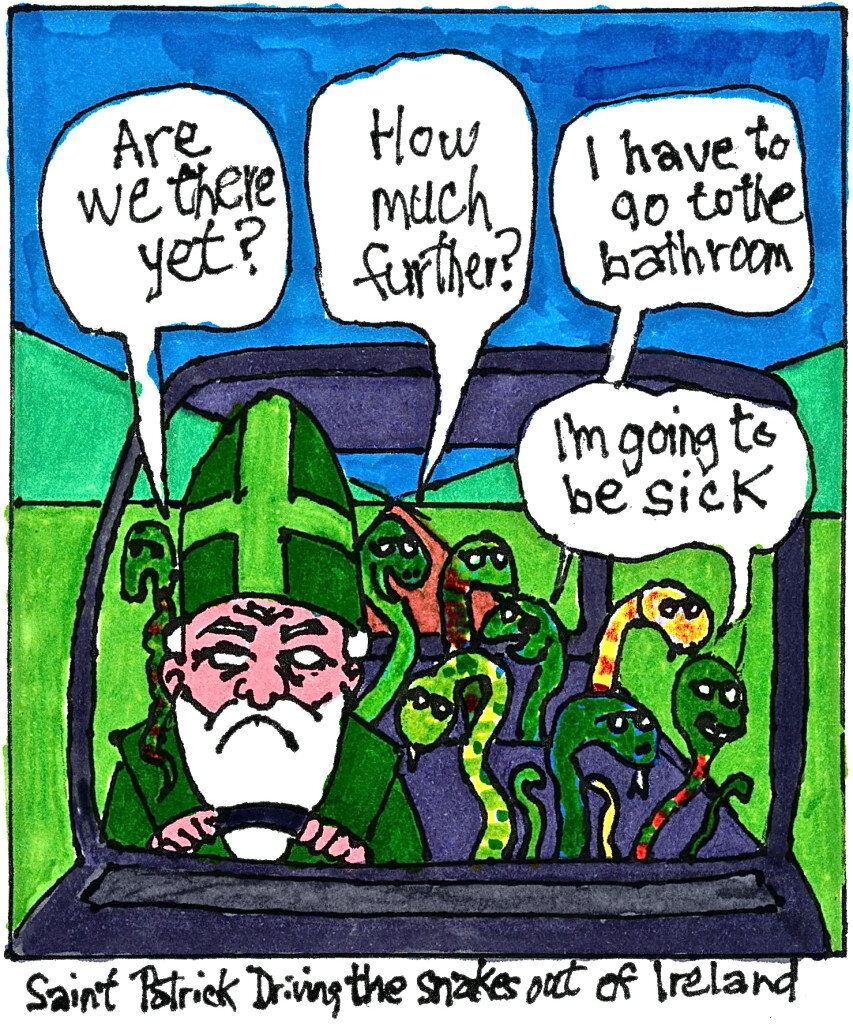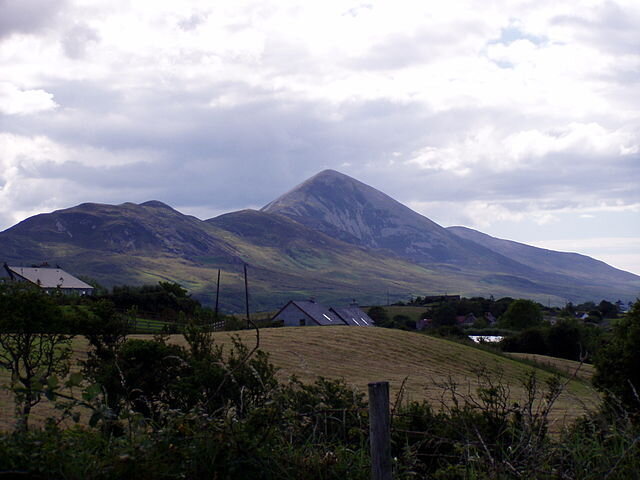Sure and His Was a Wonderful Life: Part II
Did St. Patrick Drive the Snakes Out of Ireland?
For the first article in this series, see Part I.
This week one of my Facebook friends posted a cartoon that shows St. Patrick driving a car. He’s wearing a green chasuble and miter, and he’s scowling. With him in the car are a bunch of snakes, and most of them are complaining: “ARE WE THERE YET? I HAVE TO GO TO THE BATHROOM. HOW MUCH FURTHER? I’M GOING TO BE SICK.” I’d love to post the cartoon here, but, alas, it’s copyrighted and I can’t find the owner to get permission. So I made my own version.
And today I came across this related joke, as told by the Irish: “What did St Patrick say when he was driving the snakes out of Ireland?” “Alright in the back there lads?”
Both of these jokes, of course, are humorously pooh-poohing the story that St. Patrick drove the snakes out of Ireland. Something may have happened between St. Patrick and the serpents of Ireland, but it’s hard to discern exactly what that might have been, or if the serpents in the story are meant to be taken literally or not.
Over 100,000 people a year visit Croagh Patrick, a famous pilgrimage site in County Mayo, supposedly to commemorate St. Patrick’s driving the snakes from Ireland from that spot. Croagh Patrick (Patrick’s mountain) is where St. Patrick went to fast starting on Ash Wednesday in 441. Because of the similarity between the 40 days that Patrick spent on the mountain and the 40 days spent by Moses on Mount Sinai, Croagh Patrick is called “Holy Hill” and “the Sinai of Ireland.”
The Catholic Encyclopedia actually claims very little about St. Patrick and the serpents of Ireland, in its entries titled “St. Patrick” and “Croagh Patrick.” In the “Croagh Patrick” article, the Catholic Encyclopedia says, “The account given below is taken from sources that post-date the saint’s death by three hundred years. There are, however, good reasons to believe that the traditions they embody are genuine. …. From that sacred spot on Holy Saturday [after he had fasted for 40 days], Patrick with outstretched hands solemnly blessed the men of Erin that they might cling to the Faith, and the land of Erin that no poisonous reptile might infest it.” It says nothing about St. Patrick driving out snakes, just about him blessing the land of Erin (Ireland) so that poisonous reptiles would not infect it.
One thing wrong with those jokes at the top of this piece is that there were no automobiles in the fifth century A.D., and besides, Ireland is an island, so where would he be driving them to? [Insert smiley face here.] But seriously folks, another really significant thing that’s wrong is that some scientists claim that there were actually no snakes in Ireland for St. Patrick to drive out.
A National Geographic News article “Snakeless in Ireland: Blame Ice Age, Not St. Patrick” tells us that, as a keeper of natural history at the National Museum of Ireland in Dublin, a man named Nigel Monaghan “has trawled through vast collections of fossil and other records of Irish animals. ‘At no time has there ever been any suggestion of snakes in Ireland, so [there was] nothing for St. Patrick to banish,’ Monaghan said.” Elsewhere I’ve seen it noted that because snake skeletons are so small and fragile, fossilization is uncommon. But practically everyone has jumped on that idea anyway, that the lack of snake fossils proves there never were any snakes in Ireland, and then they treat it as a foregone conclusion.
The 2008 “Snakeless in Ireland” article also said that just because there have never been snakes in Ireland, at least since the last Ice Age (or since St. Patrick’s time), that’s not to say that snakes couldn’t start living there in the future, which might happen perhaps if owners of exotic pet snakes released their pets into the wild. That turns out to have been a prophetic statement. There’s a lot of exactly that kind of thing going on in Ireland these days.
As reported in a New York Times article “Boom Over, St. Patrick’s Isle Is Slithering Again,” in March of last year (2013), it so happened that after the bust of the Celtic Tiger boom, many of the Irish nouveaux riches who had bought exotic snakes as status symbols lost their jobs. Some of the newly poor snake owners got tired of the expenses of keeping them or simply left the country. “Some left their snakes behind or turned them loose in the countryside.”
But wait, in the same National Geographic News article “Snakeless in Ireland” quoted earlier, Mark Ryan, “director of the Louisiana Poison Center at the Louisiana State University Health Sciences Center in Shreveport, agreed that the timing wasn’t right for the sensitive, cold-blooded reptiles to expand their range. ‘There are no snakes in Ireland for the simple reason they couldn’t get there because the climate wasn’t favorable for them to be there,’ he said.”
Ryan seems to be saying that even if snakes came over the water by ship, the climate was too inhospitable for snakes to survive. I’m starting to think that these different theories just don’t add up. Don’t you have to wonder why snakes would suddenly able to survive in Ireland in our day and age? I don’t think it could be global warming, since Ireland has actually had a warm climate for a long, long, time. As attested by Venerable Bede in 791 (as quoted a bit further down), Ireland is warmer than Britain, and Britain although colder than Ireland has three kinds of native snakes. Maybe it’s the high amount of precipitation, the rainfall that makes Ireland the Emerald Isle? Maybe that has made it too moist for reptiles? But wait, don’t reptiles like moisture?
You might remember that I mentioned in Part I of this series on St. Patrick that St. Bede, the author of “Ecclesiastical History of the English People,” did not write anything about the work of St. Patrick at all, even though St. Patrick had lived and worked in Ireland in the fifth century. Bede did write about the absence of snakes in the 8th century, and when he did so, he omitted St. Patrick entirely.
“Ireland, in breadth, and for wholesomeness and serenity of climate, far surpasses Britain; for the snow scarcely ever lies there above three days: no man makes hay in the summer for winter’s provision, or builds stables for his beasts of burden. No reptiles are found there, and no snake can live there; for, though often carried thither out of Britain, as soon as the ship comes near the shore, and the scent of the air reaches them, they die.”
Bede either didn’t know about St. Patrick’s missionary activity in Ireland and about the legend that St. Patrick drove the snakes out of Ireland, or he wasn’t telling, but he did believe that snakes back then couldn’t even survive one sniff of the Irish air. Apparently they could now.
Of course, every Irish school child knows that the snakes in the legend of St. Patrick were actually Druids, and no snakes were killed in the making of this legend. Oh, and do they now?
See Part III for how the Catholic Faith faded over the centuries, and how St. Patrick bargained for a return of the Faith to Ireland during a forty day fast at the end of his life.





